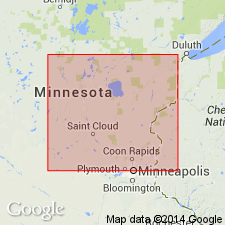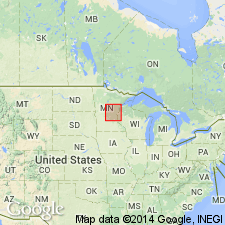
- Usage in publication:
-
- Warman quartz monzonite
- Modifications:
-
- First used
- Dominant lithology:
-
- Quartz monzonite
- AAPG geologic province:
-
- Lake Superior region
Summary:
First used for exposures along Snake River in T42N, R43N in vicinity of Ann River, Kanabec Co, central MN in Lake Superior region. Present in quarries at Isle, Pierz, and Warman [for which unit probably named]. Cut by basalt dikes and contains inclusions and roof pendants of Thomson formation. Is white to very light gray; may be weathered pink, red, or yellow. Texture is medium granitoid with poikilitic orthoclase phenocrysts 1-3 cm long; massive except locally, where there is slight foliation. Petrographic description. Generalized geologic map. Is one of five major intermediate intrusives of late Algoman age. Geologic succession places Warman between older Hillman tonalite (new) and younger Freedhem tonalite (new).
Source: GNU records (USGS DDS-6; Denver GNULEX).

- Usage in publication:
-
- Warman Granite
- Modifications:
-
- Redescribed
- Dominant lithology:
-
- Granite
- AAPG geologic province:
-
- Lake Superior region
Summary:
Redescribed as Warman Granite in northern Kanabec and parts of Aitkin and Mille Lacs Cos, central MN in Lake Superior region. Change in rank from quartz monzonite to granite reflects modal mineralogy more appropriately. 25-35 percent quartz; 25-30 percent sodic plagioclase; 18-35 percent potassium feldspar; 7-20 percent biotite. Statement referring to "type locality" near village of Warman in SE1/4 sec 5, T41N, R23W wrongly attributed to Woyski (1949). Is younger than Mille Lacs Group (new) and younger than basalt at Mora. Textural and mineralogic evidence imply age is older than Stearns Granitic Complex (redefined). Contact with Isle Granite (redefined) not observed. Is middle Precambrian in age. Generalized geologic map.
Source: GNU records (USGS DDS-6; Denver GNULEX).
For more information, please contact Nancy Stamm, Geologic Names Committee Secretary.
Asterisk (*) indicates published by U.S. Geological Survey authors.
"No current usage" (†) implies that a name has been abandoned or has fallen into disuse. Former usage and, if known, replacement name given in parentheses ( ).
Slash (/) indicates name conflicts with nomenclatural guidelines (CSN, 1933; ACSN, 1961, 1970; NACSN, 1983, 2005, 2021). May be explained within brackets ([ ]).

